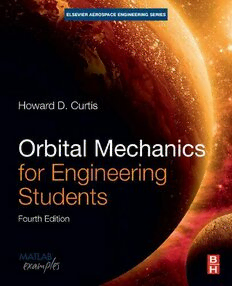
Orbital Mechanics for Engineering Students PDF
Preview Orbital Mechanics for Engineering Students
Orbital Mechanics for Engineering Students Orbital Mechanics for Engineering Students Fourth Edition Howard D. Curtis Professor Emeritus, AerospaceEngineering Embry-Riddle AeronauticalUniversity Daytona Beach,Florida Butterworth-HeinemannisanimprintofElsevier TheBoulevard,LangfordLane,Kidlington,OxfordOX51GB,UnitedKingdom 50HampshireStreet,5thFloor,Cambridge,MA02139,UnitedStates #2020ElsevierLtd.Allrightsreserved. Nopartofthispublicationmaybereproducedortransmittedinanyformorbyanymeans,electronicor mechanical,includingphotocopying,recording,oranyinformationstorageandretrievalsystem,without permissioninwritingfromthepublisher.Detailsonhowtoseekpermission,furtherinformationaboutthe Publisher’spermissionspoliciesandourarrangementswithorganizationssuchastheCopyrightClearance CenterandtheCopyrightLicensingAgency,canbefoundatourwebsite:www.elsevier.com/permissions. ThisbookandtheindividualcontributionscontainedinitareprotectedundercopyrightbythePublisher (otherthanasmaybenotedherein). MATLAB®isatrademarkofTheMathWorks,Inc.andisusedwithpermission.TheMathWorksdoesnot warranttheaccuracyofthetextorexercisesinthisbook.Thisbook’suseordiscussionofMATLAB® softwareorrelatedproductsdoesnotconstituteendorsementorsponsorshipbyTheMathWorksofa particularpedagogicalapproachorparticularuseoftheMATLAB®software. Notices Knowledgeandbestpracticeinthisfieldareconstantlychanging.Asnewresearchandexperiencebroaden ourunderstanding,changesinresearchmethods,professionalpractices,ormedicaltreatmentmaybecome necessary. Practitionersandresearchersmustalwaysrelyontheirownexperienceandknowledgeinevaluatingandusing anyinformation,methods,compounds,orexperimentsdescribedherein.Inusingsuchinformationormethods theyshouldbemindfuloftheirownsafetyandthesafetyofothers,includingpartiesforwhomtheyhavea professionalresponsibility. Tothefullestextentofthelaw,neitherthePublishernortheauthors,contributors,oreditors,assumeanyliability foranyinjuryand/ordamagetopersonsorpropertyasamatterofproductsliability,negligenceorotherwise, orfromanyuseoroperationofanymethods,products,instructions,orideascontainedinthematerialherein. LibraryofCongressCataloging-in-PublicationData AcatalogrecordforthisbookisavailablefromtheLibraryofCongress BritishLibraryCataloguing-in-PublicationData AcataloguerecordforthisbookisavailablefromtheBritishLibrary ISBN:978-0-08-102133-0 ForinformationonallButterworth-Heinemannpublications visitourwebsiteathttps://www.elsevier.com/books-and-journals Publisher:KateyBirtcher AcquisitionEditor:SteveMerken EditorialProjectManager:NathanielMcFadden ProductionProjectManager:MariaBernard CoverDesigner:VictoriaPearson TypesetbySPiGlobal,India To my beloved wife, Mary For her patience, encouragement, and love Preface Thepurposeofthisbookistoprovideanintroductiontospacemechanicsforundergraduateengineer- ing students. It is not directed toward graduate students, researchers, and experienced practitioners, who may nevertheless find useful review material within the book’s contents. The intended readers are those who are studying the subject for the first time and have completed courses in physics, dy- namics,andmathematicsthroughdifferentialequationsandappliedlinearalgebra.Ihavetriedmybest tomakethetextreadableandunderstandabletothataudience.Inpursuitofthatobjective Ihave in- cludedalargenumberofexampleproblemsthatareexplainedandsolvedindetail.Theirpurposeisnot tooverwhelmbuttoelucidate.Ifindthatstudentslikethe“teachbyexample”method.Ialwaysassume thatthematerialisbeingseenforthefirsttimeand,whereverpossible,Iprovidesolutiondetailssoasto leavelittletothereader’simagination.Thenumerousfiguresthroughoutthebookarealsointendedto aid comprehension. All of the more labor-intensive computational procedures are accompanied by ® MATLAB code. For this, the fourth edition, I have retained the content and style of the previous editions and corrected all the errors discovered by me or reported to me by readers. Except for the new Chapter9onbasiclunartrajectoriesandanexpandeddiscussionofquaternionsinChapter11thebook remainsessentially the same. Adding the new chapter required the following reshuffling: Topic Thisedition Previousedition Lunartrajectories Chapter9 Absent Introductiontoorbitalperturbations Chapter10 Chapter12 Rigidbodydynamics Chapter11 Chapter9 Satelliteattitudedynamics Chapter12 Chapter10 Rocketvehicledynamics Chapter13 Chapter11 The organization of the book remains the same as that of the third edition. Chapter 1 is a review of vectorkinematicsinthreedimensionsandofNewton’slawsofmotionandgravitation.Italsofocuses ontheissueofrelativemotion,crucialtothetopicsofrendezvousandsatelliteattitudedynamics.The materialonordinarydifferentialequationsolverswillbeusefulforstudentswhoareexpectedtocode numericalsimulationsinMATLABorotherprogramminglanguages.Chapter2presentsthevector- basedsolutionoftheclassicaltwo-bodyproblem,resultinginahostofpracticalformulasfortheanal- ysisoforbitsandtrajectoriesofelliptical,parabolic,andhyperbolicshape.Therestrictedthree-body problemiscoveredtointroducethenotionofLagrangepointsandtopresentthenumericalsolutionofa lunartrajectory problem. Chapter 3 derives Kepler’s equations,which relate position totime for the different kinds of orbits. The universal variable formulation is also presented. Chapter 4 is devoted todescribingorbitsinthreedimensions.CoordinatetransformationsandtheEulerelementaryrotation sequences are defined. Procedures for transforming back and forth between the state vector and the classicalorbitalelementsareaddressed.Theeffectoftheearth’soblatenessonthemotionofanorbit’s ascendingnodeandeccentricityvectorisdescribed,pendingamoredetailedexplanationinChapter10. Chapter5isanintroductiontopreliminaryorbitdetermination,includingGibbs’andGauss’methods andthesolutionofLambert’sproblem.Auxiliarytopicsincludetopocentriccoordinatesystems,Julian xiii xiv Preface daynumbering,andsiderealtime.Chapter6presentsthecommonmeansoftransferringfromoneorbit to another by impulsive delta-v maneuvers, including Hohmann transfers, phasing orbits, and plane changes.Chapter7isabriefintroductiontorelativemotioningeneralandtothetwo-impulserendez- vousprobleminparticular.Thelatter isanalyzed usingtheClohessy-Wiltshireequations,whichare derived in this chapter. Chapter 8 is an introduction to interplanetary mission design using patched conics. Chapter 9 extends the patched conic method and the restricted three-body approach to lunar trajectoryanalysis.Chapter10isanintroductiontocommonorbitalperturbations:drag,nonspherical gravitationalfield,solarradiationpressure,andlunarandsolargravity.Chapter11presentsthoseel- ementsofrigidbodydynamicsrequiredtocharacterizetheattitudeofaspacevehicle.Euler’sequa- tionsofrotationalmotionarederivedandappliedinanumberofexampleproblems.Eulerangles,yaw- pitch-roll angles, and quaternions are presented as ways to describe the attitude of rigid body. Chapter 12 describes the methods of controlling, changing, and stabilizing the attitude of spacecraft bymeansofthrusters,gyros,andotherdevices.Chapter13isabriefintroductiontothecharacteristics and design ofmultistage launchvehicles. Chapters 1 through 4 form the core of a first orbital mechanics course. The time devoted to Chapter1dependsonthebackgroundofthestudent.Itmightbesurveyedbrieflyandusedthereafter simply as areference. What followsChapter4 depends onthe objectives of the course. Chapters5through10carryonwiththesubjectoforbitalmechanics.Chapter6onorbitalmaneu- vers should be included in any case. Coverage of Chapters 5, 7, 8, and 9 is optional. However, if Chapters8and9oninterplanetaryandlunarmissionsistoformapartofthecourse,thenthesolution ofLambert’s problem (Section 5.3) must bestudied beforehand. Chapter10isappropriateforacoursedevotedexclusivelytoorbitalmechanicswithanintroduction toperturbations, which is awhole topic unto itself. Chapters11and12mustbecoveredifthecourseobjectivesincludeanintroductiontospacecraft dynamics. Inthat case Chapters 5, 7,8, and 9wouldprobablynot bestudied indepth. Chapter13isoptionaliftheengineeringcurriculumrequiresaseparatecourseinpropulsioninclud- ingrocketdynamics. Theimportanttopicofspacecraftcontrolsystemsisomitted.However,thematerialinthisbookand a course incontrol theoryprovidethe basisfor the study ofspacecraft attitude control. Tounderstandthematerialandtosolveproblemsrequiresusingalotofundergraduatemathemat- ics.Mathematics,ofcourse,isthelanguageofengineering.StudentsmustnotforgetthattheEnglish mathematicianandphysicistSirIsaacNewton(1642–1727)hadtoinventcalculussohecouldsolve orbitalmechanicsproblemsinmorethanjustaheuristicway.Newton’s1687publicationMathemat- icalPrinciplesofNaturalPhilosophy(“thePrincipia”)isoneofthemostinfluentialscientificworksof all time. It must be noted that his contemporary, the German mathematician Gottfried Wilhelm von Leibnitz (1646–1716) is credited with inventing infinitesimal calculus independently of Newton in the 1670s. Inadditiontohoningtheirmathskills,studentsareurgedtotakeadvantageofcomputers(which, incidentally, use the binary numeral system developed by Leibnitz). There are many commercially available mathematics software packages for personal computers. Wherever possible they should be used to relieve the burden of repetitive and tedious calculations. Computer-programming skills can andshouldbeputtogooduseinthestudyoforbitalmechanics.TheelementaryMATLABprograms referredtoinAppendixDofthisbookillustratehowmanyoftheproceduresdevelopedinthetextcan Preface xv be implemented in software. All the scripts were developed and tested using MATLAB version 9.2 (release 2017a). Information about MATLAB, which is a registered trademark of The MathWorks, Inc., may beobtained from TheMathWorks, Inc. 3 Apple Hill Drive Natick,MA 01760-2089,USA www.mathworks.com AppendixApresentssometablesofphysicaldataandconversionfactors.AppendixBisaroadmap throughthefirstthreechapters,showinghowthemostfundamentalequationsoforbitalmechanicsare related. Appendix C shows how to set up the n-body equations of motion and program them in MATLAB. Appendix D contains listings of all the MATLAB algorithms and example problems presentedinthe text.Appendix Eshowsthatthe gravitational field ofasphericallysymmetric body is the same as if the mass were concentrated at its center. Appendix F explains how to deal with a computational issuethat arises in some perturbation analyses. SUPPLEMENTS TO THE TEXT Forpurchasersofthebook,copiesoftheMATLABM-fileslistedinAppendixDcanbefreelydown- loadedfromthisbook’scompanionwebsite.Alsoavailableonthecompanionwebsiteareasetofan- imationsthataccompanythetext.Toaccessthesefiles,pleasevisithttps://www.elsevier.com/books- and-journals/book-companion/9780081021330. Forinstructorsusingthisbookforacourse,pleasevisitwww.textbooks.elsevier.comtoregisterfor accesstothe solutions manual,PowerPoint lecture slides, and other resources. ACKNOWLEDGEMENTS Sincethepublicationofthefirstthreeeditionsandduringthepreparationofthisone,Ihavereceived helpfulcriticism,suggestions,andadvicefrommanysourceslocallyandworldwide.Ithankthemall and regret that time and space limitations prohibited the inclusion of some recommended additional topics thatwouldhave enhancedthe book. IthasbeenapleasuretoworkwiththepeopleatElsevier,inparticularJosephP.Hayton,Publisher; Steve Merken, Senior Acquisitions Editor; and Nate McFadden, Senior Developmental Editor. Iappreciatetheirenthusiasmforthebook,theirconfidenceinme,andalltheworktheydidtomove this project tocompletion. Finallyandmostimportantly,Imustacknowledgethepatienceandsupportofmywife,Mary,who was a continuous source ofoptimismand encouragement throughout the revision effort. Howard D.Curtis DaytonaBeach,FL,UnitedStates CHAPTER 1 DYNAMICS OF POINT MASSES 1.1 INTRODUCTION Thischapterservesasaself-containedreferenceonthekinematicsanddynamicsofpointmassesas well as some basic vector operations and numerical integration methods. The notation and concepts summarizedherewillbeusedinthefollowingchapters.Thosefamiliarwiththevector-baseddynamics ofparticlescansimplypagethroughthechapterandthenreferbacktoitlaterasnecessary.Thosewho need abitmoreinthewayofreview willfindthatthechaptercontainsallthematerialtheyneed to followthe development oforbitalmechanicstopics inthe upcomingchapters. Webeginwithareviewofvectorsandsomevectoroperations,afterwhichweproceedtotheprob- lem of describingthe curvilinear motion ofparticles in three dimensions. The concepts of force and mass are considered next, along with Newton’s inverse-square law of gravitation. This is followed by a presentation of Newton’s second law of motion (“force equals mass times acceleration”) and the important conceptofangular momentum. Asapreludetodescribingmotionrelativetomovingframesofreference,wedevelopformulasfor calculating the time derivatives of moving vectors. These are applied to the computation of relative velocityandacceleration.Exampleproblemsillustratetheuseoftheseresults,asdoesadetailedcon- siderationofhowtheearth’srotationandcurvatureinfluenceourmeasurementsofvelocityandaccel- eration.ThisbringsinthecuriousconceptofCoriolisforce.Embeddedinexercisesattheendofthe chapterispracticeinverifyingseveralfundamentalvectoridentitiesthatwillbeemployedfrequently throughout the book. The chapter concludes with an introduction to numerical methods, which can be called upon to solvethe equations ofmotion when an analyticalsolution is not possible. 1.2 VECTORS Avectorisanobjectthatisspecifiedbybothamagnitudeandadirection.Werepresentavectorgraph- icallybyadirectedlinesegment(i.e.,anarrowpointinginthedirectionofthevector).Theendopposite thearrowiscalledthetail.Thelengthofthearrowisproportionaltothemagnitudeofthevector.Ve- locityisagoodexampleofavector.Wesaythatacaristravelingeastwardat80km/h.Thedirectionis eastandthemagnitude,orspeed,is80km/h.Wewilluseboldfacetypetorepresentvectorquantities and plain type todenotescalars.Thus,whereas B is ascalar, Bis avector. 1 OrbitalMechanicsforEngineeringStudents.https://doi.org/10.1016/B978-0-08-102133-0.00001-5 #2020ElsevierLtd.Allrightsreserved. 2 CHAPTER 1 DYNAMICS OF POINT MASSES FIG.1.1 AllofthesevectorsmaybedenotedA,sincetheirmagnitudesanddirectionsarethesame. FIG.1.2 Parallelogramruleofvectoraddition.A+B¼C. Observe thatavector is specified solely by itsmagnitude anddirection. If Ais avector,then all vectorshavingthesamephysicaldimensions,thesamelength,andpointinginthesamedirectionasA aredenotedA,regardlessoftheirlineofaction,asillustratedinFig.1.1.Shiftingavectorparallelto itselfdoesnotmathematicallychangethevector.However,theparallelshiftofavectormightproduce a different physical effect.Forexample, an upward 5-kN load (force vector) applied to the tip ofan airplanewinggivesrisetoquiteadifferentstressanddeflectionpatterninthewingthanthesameload acting at the wing’s midspan. The magnitude ofa vector Ais denotedkAk, or,simplyA. MultiplyingavectorBbythereciprocalofitsmagnitudeproducesavectorthatpointsinthedi- rectionofB,butitisdimensionlessandhasamagnitudeofone.Vectorshavingdimensionlessmag- nitudearecalledunitvectors.Weputahat(^)overtheletterrepresentingaunitvector.Thenwecantell simply by inspectionthat, for example,u^ is a unit vector, as are B^ and^e. ItisconvenienttodenotetheunitvectorinthedirectionofthevectorAasu^ .Aspointedoutabove, A we obtainthis vector from Aas follows: A u^ ¼ (1.1) A A Likewise,u^ ¼C=C,u^ ¼F=F, etc. C F Thesumorresultantoftwovectorsisdefinedbytheparallelogramrule(Fig.1.2).LetCbethesum ofthe two vectors AandB.To formthat sum using the parallelogram rule, the vectors Aand Bare
